TrainsInGames.com
Bioshock Infinite
Bioshock Infinite, sequel to Bioshock and Bioshock 2, is a game about american labor and race relations shortly before the start of the first world war. Also shooting people who want to shoot you. All that is embedded in a grandiose Beaux Arts environment and features lots of science fiction. A big part of this: One of the most stylish transportation systems ever.
The City in the Clouds
There are literal trains here as well as other things that I consider to be in the scope of of this site. But the most impressive part, and the foundation without which anything makes sense, is the city of Columbia and its approach to real estate. In particular, it floats.
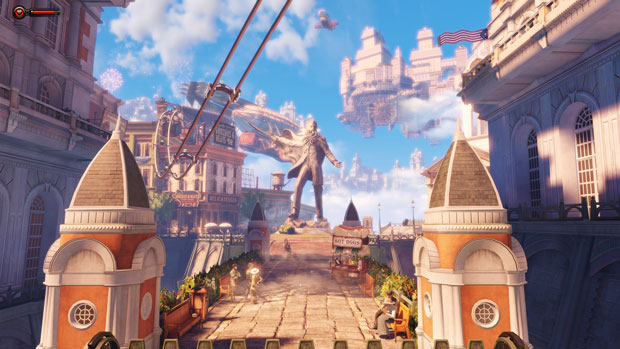
Isn't it pretty? If they offered a big post card box of Columbia for the same price as the game, I'd probably buy that too. Not that it would be a good investment, seeing how I can and do take high-resolution screenshots all the time anyway, but still.
Of course, modern technology doesn't have anything to make cities float, and 1893 (when the city was built) certainly didn't either, so there is no attempt to try to sell us on giant balloons or the like. Apparently the city floats due to quantum effects, discovered by a genius inventor. This is surprisingly plausible: Max Planck presented the first bits of what became quantum theory in 1895, with rapid development in the early 1900s and 1910s. In the game's alternate universe, one lone genius apparently developed all of it and then some maybe ten years earlier. I'm willing to accept that.
Getting around a floating city is a challenge of its own, and the hinhabitants use a variety of different solutions for this. Not a problem, oddly enough: Wind or cold air at that height.
Here Today, Gone Tomorrow
To a large part, the city is modular. Houses can and do dock and undock from city streets, so some stores can be in one part of the city in the morning and in another in the evening.
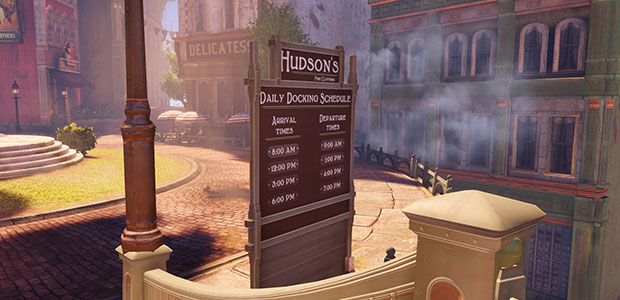
Sadly, not much is made of this technology, and after some point, the game forgets it entirely. You just end up running around normal city squares, just with way more opportunities to fall down.
The Air is an Ocean
It's 1912, the waning days of steampunk, and what could this mean other than airships? Yes, the city has its fair shair of different types of aerial naval vessels. Many of them feel very distinctly ship-based.

Whether that design helps anyone is up for debate; you can't really see other traffic well, especially traffic coming from above or below. All in all, there does not seem to be enough traffic in Columbia to make this a problem, but when modern planes come up, that design won't be sustainable. Other versions that evoke tram cars of the area look arguably more reasonable.
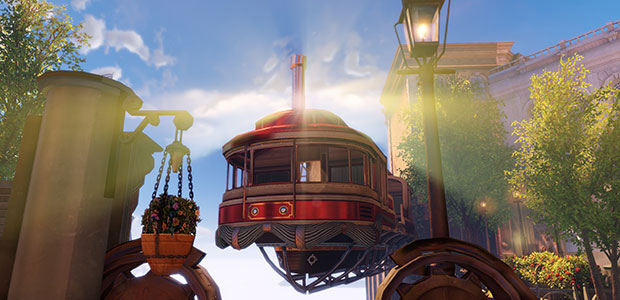
This type also runs essentially as cable cars. Unlike cable cars, it's always a single car on the line, with no counterweight. That takes more power, but electric power seems to be essentially free in this world, so who cares? It's also not made clear whether the cars are suspended or floating and just guided by the lines.
Finally, there's traditional airships. You'd think they'd be the most realistic, considering that those actually existed, but sadly, the closer you get to real life, the more the differences to it become noticeable. It's an airborne uncanny valley.
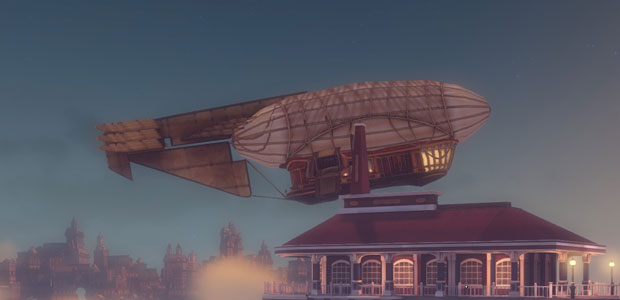
For a start, the airships have an aerodynamic form, while all actual airships at that time were simple cylinders with pointed ends. Of course, Columbia might have developed aerodynamics earlier; you'd imagine it'd be a big deal for them.
A bigger problem is that the airships don't work. Their hulls are generally too small to support the weight of whatever is suspended below, and some airships (in particular one near the end) don't seem to contain any gas at all. Apparently they're at least partly kept up by the same pseudo-scientific things that let the city float. But then why bother building airships to begin with, when the smaller vessels seem much more practical? The game's ending provides no answer.
As for Railroads...
But a mere floating city wouldn't be enough to warrant inclusion on this site. It also takes something that fits within the wider definition of "train", and thankfully, Infinite delivers.
Skylines
A key part of the transport system are the skylines, track systems suspended in the air, used for freight transport. It is possible to ride them, a feature first used by dissidents, then the police, and finally you.
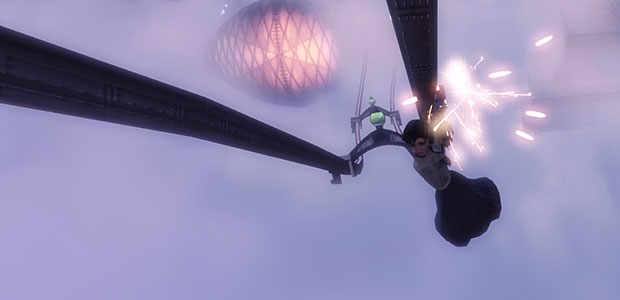
The design appears surprisingly sensible. Two parallel tracks sounds a lot like railways. The tracks themselves appear to be powered (you get automatically propelled when you're on them), which makes it unnecessary to have drivers or, for that matter, couplings between the cars. On longer stretches, the tracks are regularly suspended in the air, using probably the same flotation technology that is the foundation of the entire thing. There are hints that skylines are reversible; the track you hang on decides in which direction you're going. I believe that the cars have some sort of peg that interfaces with this propelling technology. Changing where the peg sits reverses the train's direction. Some local control also applies: You can slow down or accelerate.
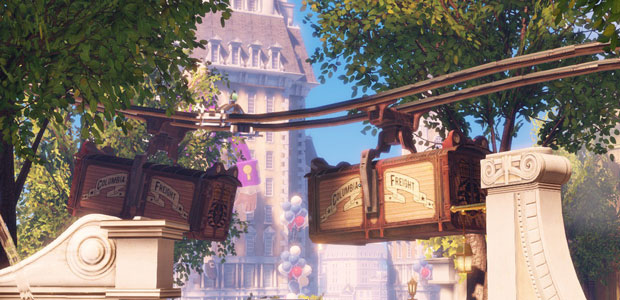
Powered tracks were seen as the future in the 1970s; in particular, all maglev trains have the power source in the track, not the vehicle. Maglevs essentially failed, and for good reason, but power in the tracks is used on some metro lines today, for example in Tokyo. The technology basically works by unwinding an electric motor and making it really long. An electric field travels along the tracks and "pulls along" the train. While it sounds modern, the first of its kind was patented in 1854.
Not that this is Columbia's only option: Cable cars of the type used in San Francisco have a similarly powered track, with a steel cable embedded in the track. Trains hold on to it or not. It probably fits even better, because it is not affected by electric shocks that some enemies send through it. Maintaining a cable inside the tracks would be difficult. Also, in 1893, nobody would have built a new cable car system anymore; the technology was considered outdated by that point already, even though it had been invented only twenty years prior.
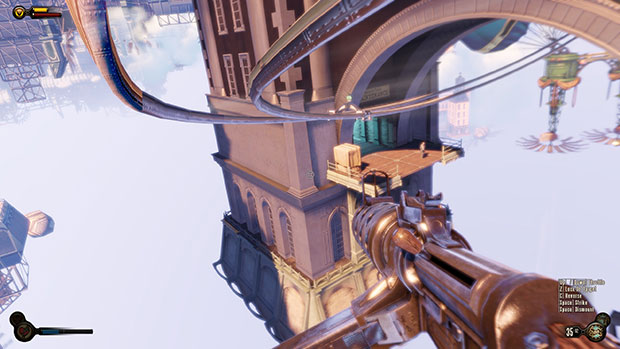
Stations are typically short, for three or four car trains at most and often less. That makes sense, since you typically don't see longer trains to begin with. Likewise, there are no switches of any sort, although a turntable can be seen to make a sharp right turn at one place. The skylines don't seem to form a connected system. Rather, they are local lines to move freight within indivudal islands. Anything else wouldn't make a lot of sense in a city where the neighborhoods can literally swap places over night.
The cars themselves are just clamps that hold containers. The running gear is an interesting adaption of the american three-piece railway truck. It's really, really hard to get historic information about american freight car trucks (though if you're interested in german ones, http://www.drehgestelle.de/ should have you covered), but it doesn't seem completely unreasonable here.
Sadly, near the end of the game, sense and meaning breaks down. Skylines appear that exist simply to bring you around a battlefield, with no station, no switches, no trains and not the slightest bit of meaning behind their looping structures. You can ride them forever (probably where the title comes from), but there doesn't seem to be any reason why the lines were ever built in the first place. That's just cheap.
Also, Trains
On the one hand, a floating city is probably the last place where you'd expect trains; you can't connect to any network, for example. On the other hand, this is 1912, and railroads were still the de-facto way to move anything at the time. While skylines handle most of the freight in the posher areas, apparently they don't come as cheap as just putting two steel rails on wooden ties on the ground, which is arguably not that surprising. So in the industrial area of Finkton, heavy stuff gets moved by standard rails.
Infrastructure
And by rails, we mean just rails. There are no ties anywhere on the system. And in a way much like Dishonored's tram system, the tracks are placed on top of the street instead of laid in.

The rails themselves look weird, with lots of different stripes. The actual model is just a typical rectangular cross-section, so it's not obvious what this is supposed to portray. Finally, note the rail gauge. Yes, it is one my favorite common sins again: Wrong rail gauge. To give some perspective: Wanted posters describe little Elizabeth here as 5" 1/2, which apparently translates to 1.65 m in useful units. The tracks appear to be a good twenty centimeters further apart than she is high, bringing the total to at least 1.8 m. This is larger than any gauge in actual use today (not counting special cases like cranes), and it means trains will have problems going through tight curves. Good thing there aren't any on an industrial tram way, right?
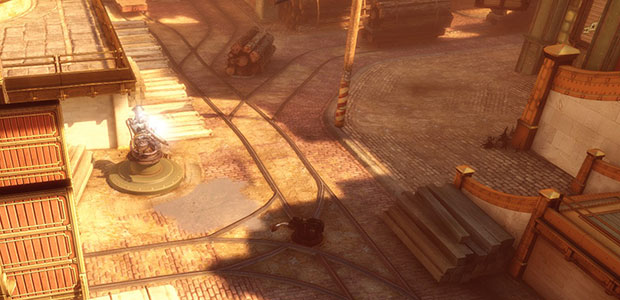
Damn.
Rolling stock
Compared to the tracks, the rolling stock is awesome. The gauge is too wide, but everything else fits. I love it.
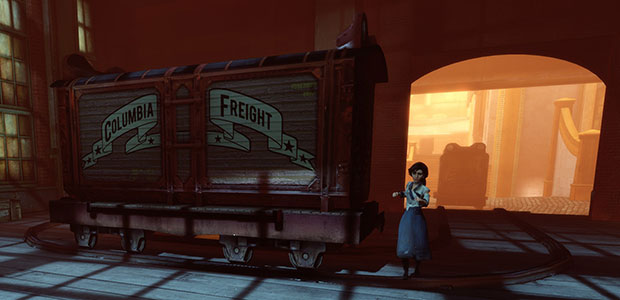
All train cars are just platforms. Most of them transport the same kind of containers as seen on skylines and boats. The train cars themselves have no obvious means of securing this freight, but we'll just assume that this is being handled somehow. Each of these cars has two incredibly short trucks with tiny wheels. Those won't give a good right at higher speeds, but for the purposes here, they are adequate, and vaguely similar designs are in fact still used on narrow-gauge trains today, for example on the HSB network in Germany.
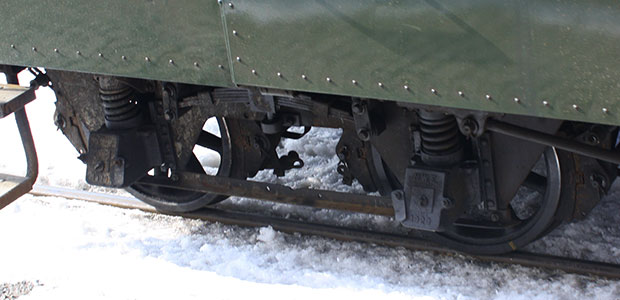
The coupler design seems like a pin and link coupler. This was standard on early american railroads and cheap, but had a lot of troubles. For example, they're not safe, since a crew member has to be between the cars while they're pushed together. They don't create a tight connection, and they are not standardized. For such reasons, they were phased out and made illegal on the national american network by 1900. On an isolated industrial network like Columbia's, however, they would have still been legal (even ignoring that Columbia declared itself independent in 1901). Slack wouldn't matter at the low speeds, and on this isolated network, standardization would not be an issue. Finally, as for industrial health and safety…
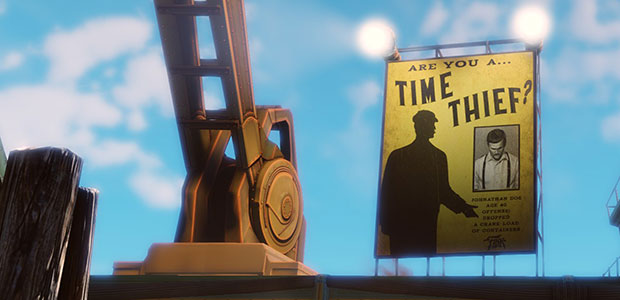
The guy paying the bills probably does not mind the odd industrial accident.
Propulsion
If there is a problem with the whole thing, it's the locomotives. There are none, which would be acceptable - after all, we only see a very tiny part of the system. But at some point, the game tries to put one in anyway, and to do that, they choose… a mechanical horse, of a type used for road transport.
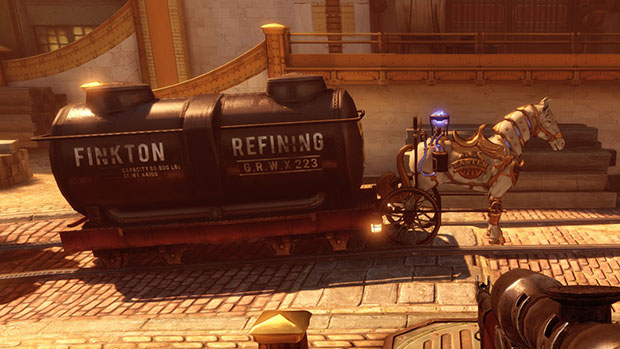
Of course, there is no link between horse and car. They're just placed closely together, with the implied hope that we won't notice. The horse's rear wheels have a narrower gauge than the train, so going over switches will be a challenge. And there is no indication how the mechanical horse is controlled. Oh, and of course, it doesn't actually move, so one could have just done away with the horse and all would have been fine.
It might make sense to assume that horses would be used for switching jobs in a pinch. But then they'd probably have a better system to connect it all. This really just seems lazy. Which arguably makes it unique within this richly detailed game.
Model Trains in Games
While Columbia is worse for the wear after you're through with it, it is still very much a functional town, and there is an open toy store to peruse. It even has a model railway!
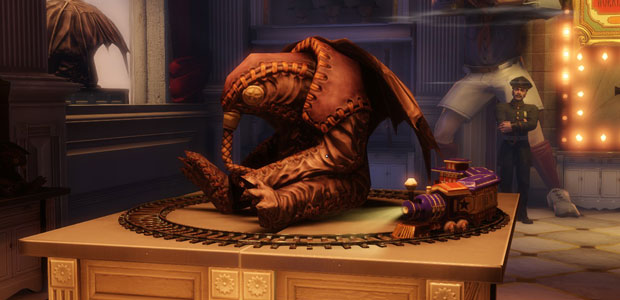
First of all, unrelated to the rest, I totally want a plush Songbird. Second, the train doesn't make sense. The engine is lacking a tender, a passenger train wouldn't have a caboose, and the gauge of the front wheels isn't enough. But compared to real model railroads of 1912, it almost looks too good. It was a different time in model making.
Just one question: Why are model railroads sold in Columbia at all? Children growing up there have probably never seen a steam-powered railroad (at least not the upper class children whose families could afford it). A model skyline, or one of the airships, would probably make more sense.
Containerization
One transportation-related aspect that I really love is containerization. I've mentioned it before: The railroads, skylines and barges all use the same type of interchangeable container to move stuff around. While it isn't shown, one can assume that they can quickly change between the different modes.
In reality, 1912 had no such technology, but that doesn't make it implausible here. In 1912, there were simply too many cheap workers to make such a technology necessary. Columbia is modern and believes in technology, though, so it makes a lot of sense that they would adopt this essentially very simple approach way before its time.
An interesting note are the numbering marks that appear on some of the containers.
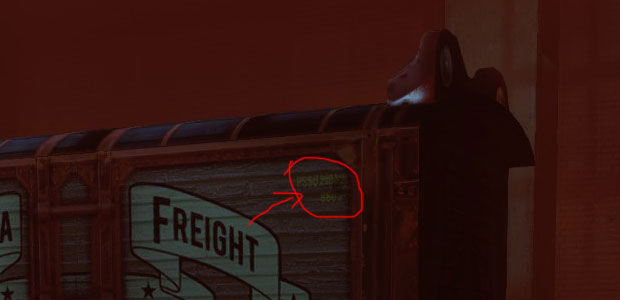 .
.
Those are not just in line with those of modern containers; they're actually identical, in their form of four letters (ending with "U" for freight containers) and a number string. This is the so-called Standard Carrier Alpha Code. Oddly enough, this makes sense again: This code developed from american railway practice that was already in use at the time. The "U" is arguably ahead of its time, but perhaps it means something different in the Columbia system.
The system also has tank containers, which again look fairly reasonable.
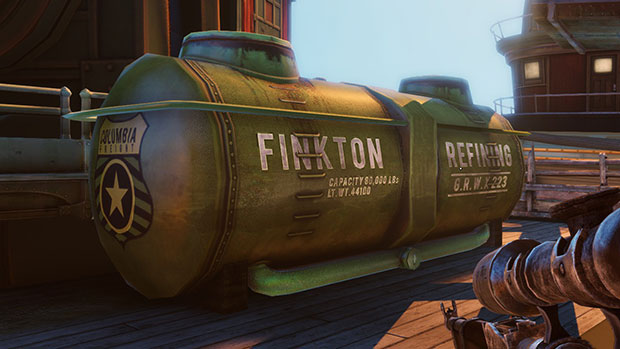
Two domes are maybe a bit much for such a short vehicle, but the position of the grab area for clamps makes it necessary. The tank containers have codes, too, but those are a bit more problematic, since they end in "X".
That may make sense in Columbia's own identification system, but I think it's a simple mistake. Codes with letters ending in "X" identify privately owned rolling stock (by anyone who is not a common carrier). Tank cars are very common in this group; they're a highly specialized design and most often owned by companies that rent them out to railroads or shippers. One could easily think that all tank codes have to end in "X", but in reality, for a container, it is "U", while "X" is seen on a lot of other rolling stock, too.
That sounds incredibly nit-picky, and it is. I think it's a good sign when little things like this are among the worst problems.
Special Aside: Gears
Gears aren't trains, nor other transportation, but they are an essential part of a lot of transportation devices, and they're one of the basic building blocks of all interesting technology. Most games, however, treat them as purely decorative elements, and Bioshock Infinite is no exception.
Instead of nitpicking my way through, I thought I'd provide some very basic rules how to do gears properly.
Gears have to drive something.
Gears can't just sit there. There has to be an opposite gear that is driven by the gear or that the gear drives (worm gears work, too, but I've never seen one in any video game). Columbia does like violating that.
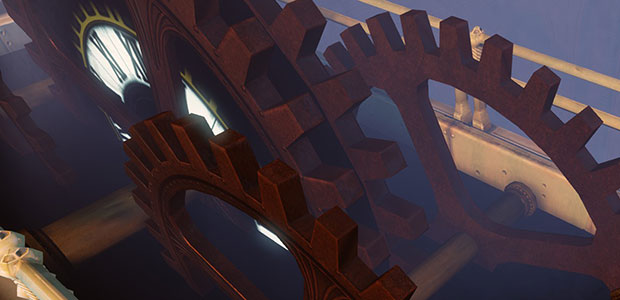
Gears must overlap
The teeth on one gear have to fit within the teeth of the next, similar to a ziplock. That's how a gear transmits its power. Engineers have precise rules for calculating this overlap, but to get a first approximation, at the closest point, there should be a gap of about 10% the teeth's length between one gear's teeth and the other gear's gap. What does not work: Have the circumferences of the gears touch. Especially if the gears are positioned so that there is no actual contact anywhere.
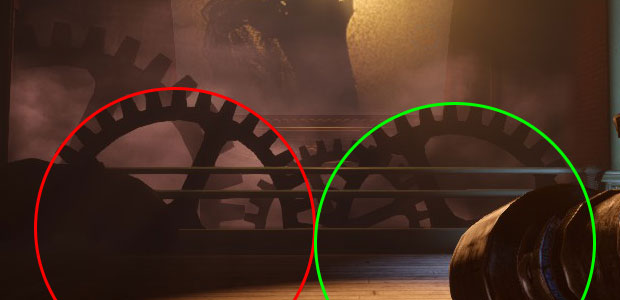
Tooth dimenions must match
Teeth dimensions are precisely regulated in industry standards. One thing that nobody ever bothered to write down, because it seems absolutely obvious, though: One tooth goes in one gap on the other side. One gap, one tooth. Who could ever violate that?
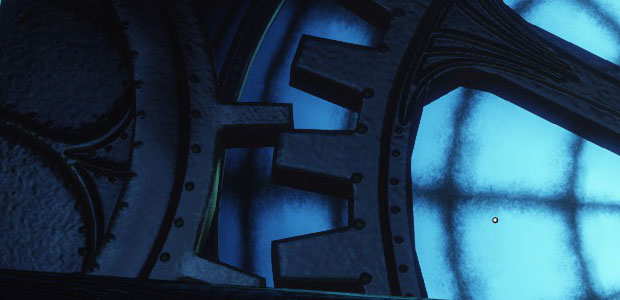
I'm willing to accept a lot of crap, including the use of rivets on what looks like a single cast piece, or that all gears appear to be differently scaled versions of the same art asset (which would produce serious problems in real life). But that design is just plain stupid.
Of course, as I said before: Praised be the game where this is the worst problem. Still, a bit of common sense could have prevented all of these.
The Game
Note: This section is irrelevant for the final score.
It's a game where you shoot at people, all of whom are generally shooting at you first. As such games go, it's a very good one, with lots of variation and different tactics. But this isn't a game about shooting at people in the way that e.g. Portal is about creating Portals. All that shooting is basically just a backdrop.
The real core of the experience is its narrative. It's inredibly rich, detailed, and a joy to experience, even though many parts won't make sense until the very end. An end that is rather weird, by the way. It's a story and ending that I could write about for hours, but that's not why either of us are here, so let me just give you a quick overview:
Columbia is a city run by racist zealots, worshipping a prophet as if he was God and following their own twisted version of the american dream. At the start, it appears funny, but you quickly see that this is a deeply hate-filled city. There is a resistance, too. The focus lies elsewhere, though, on the exceedingly odd story of Elizabeth, a resourceful young woman with a very troubled past. Getting her out of the city is your mission, but the different groups don't make it easy on you, and her powers don't help a lot either.
In practice, Elizabeth is arguably one of the flakiest parts of the game. She follows you everywhere, but she also has a mind of her own. In particular, she likes to run ahead to where the game assumes you'll go next. That rarely works out, since the game rewards and in fact demands scrounging all areas for supplies and money, so you'll soon find her stuck in a loop of going where she thinks you'll go, realizing that's not where you are, and returning. A few times, I lost her completely (unrelated to the story). She appeared back right when I needed her to open a door, apparently teleported from wherever she had managed to get stuck.
While her story is touching, it is always a bit jarring when you get new powers and features in fights because Elizabeth decided they'd be useful (for example when she starts throwing you ammunition and health items). She sounds a bit like a tutorial here. Perhaps the least useful part are lockpicks. She needs them to open doors for you, and will, occasionally, point out lockpicks that lie around, so you can take them. Why she won't take them herself is a mystery that not even the incredibly mythology-dense ending can answer.
The game almost never takes control from you, except in parts where your character is restrained, and there are no quick-time events or similar nonsense. Still, it is rather linear, and key parts will play out in exactly one way, with your input reduced to a simple unimportant choice, or simply deciding to do your pre-scripted part now or later. I can forgive that, though, because the parts are done very well. But I know of others who like this less.
Finally, probably the most notable aspect of the game is that it is oh so pretty. The art direction is superb, the light shines through, water glistens, oil puddles shine… this is the best looking game I have on my computer, and interestingly enough, it manages to do so even on just medium settings.
All in all, I'd call it probably the best game I've first played in the last twelve months, and with e.g. Dishonored or the new Tomb Raider (no trains, so my review is on my blog), there are some strong contenders there.
Final verdict
I admit that I went looking for something to criticize, and I found it. But personally, in reality, I don't actually care. Bioshock Infinite set out to create an entire fictional world, with several overlapping and competing modes of transportation that were completely irrelevant to the actual story, and it did it with an attention to detail that most games portraying the real world don't have. As long as you accept the basic conceit of a city floating in the sky, and the technology necessary for it, then all the rest generally fits and makes sense. So I think that one can honestly call this a game with Good trains.